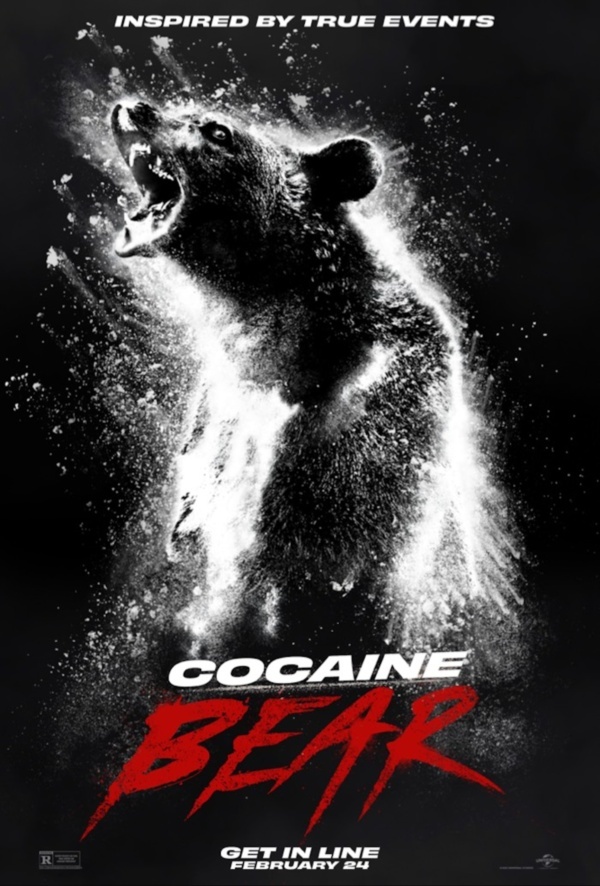Loosely inspired by the true story of an American black bear that fatally overdosed on cocaine, Elizabeth Banks’ much anticipated black comedy “Cocaine Bear” was released in theaters on February 24. Rising to internet fame after a wildly successful marketing campaign, Banks’ third directorial feature has seen success at the box office, opening with an impressive $23,260,790 during its first weekend in North America.
The film follows three separate but interwoven narratives, each with characters who enter the Blood Mountain Wilderness in northern Georgia for their own reasons and end up at the mercy of the titular drug-fueled beast following a cartel drug shipment gone awry. From a distressed single mother searching for her child to a drug boss looking to recover his lost merchandise, Banks presents a colorful array of compelling and accessible characters.
As exemplified in a “Jaws”-esque opening scene, during which the ursine drug fiend brutalizes a carefree vacationing Scandinavian couple, “Cocaine Bear” does not shy away from uncensored gore and violence. In fact, Banks uses the almost overbearing extent of macabre content to enhance the equally frequent moments of levity and borderline-inane humor, a mixture of extremes that give the film a sense of comedy in and of itself. While at times this alternation of tone can be a bit too much, the film achieves a good balance to harness this absurdity for its own benefit. Even standing alone, the film has the makings of a strong comedy, adeptly repurposing dramatic irony for humorous effect.
On its own, the abundance of trite, half-baked jokes could lead to the perception that “Cocaine Bear” is merely an embarrassing attempt by a large studio at mimicking a B movie. However, in the context of the film, everything makes sense. While critics could point out one flaw after another, the truth is that this is not a movie that is designed to be taken seriously. In its own chaotic way, the film’s absurd and unfiltered approach to storytelling is beautiful.
However absurd their actions and appearances may be, every character has fundamentally understandable motivations, and the plot itself is mostly cohesive and well-paced. In spite of the implausibility of the narcotized bear’s feats, every scene remains captivating for the audience. While billed as a sort of horror movie, especially in its targeted usage of Mark Mothersbaugh’s gripping film score, the film functions much better as a caricature of a horror film, using its own nonsensical characteristics to further its border comedic impact.
Moreover, the actors themselves deliver their performances with tangible passion in each scene of the film, which stars a stellar ensemble cast including Keri Russell, O’Shea Jackson Jr., Alden Ehrenreich, Margo Martindale, and the late Ray Liotta — to whom the film is dedicated—best known for his roles in the landmark films “Goodfellas” and “Field of Dreams”. Even in terms of cinematography, the film fares well, adding tension and anticipation to already thrilling scenes.
Of course, “Cocaine Bear” is not a flawless film. The balance it achieves between complete absurdity and realism is sullied by some dubious moralizing leading up to the film’s climax. Additionally, the film is littered with one-liners and scenes that seem to have been tailor-made solely for the purpose of the trailers without adding any real value to the movie itself.
In spite of such shortcomings, the film stands as a uniquely impressive blockbuster, providing both comic relief and thought-provoking commentary at once. Addressing issues of crime, delinquency, and morality itself and satirizing its setting in the late 20th century South, Banks uses the film as a sort of comical representation of nature’s recourse to human misdeeds. Through this lens, the bear’s drug-fueled rampage can serve as consequential revenge for ecological damage caused by human actions.
Ultimately, regardless of how ridiculous its name may seem, “Cocaine Bear” is a phenomenal movie and certainly worthy of being seen in theaters.
*4/4

